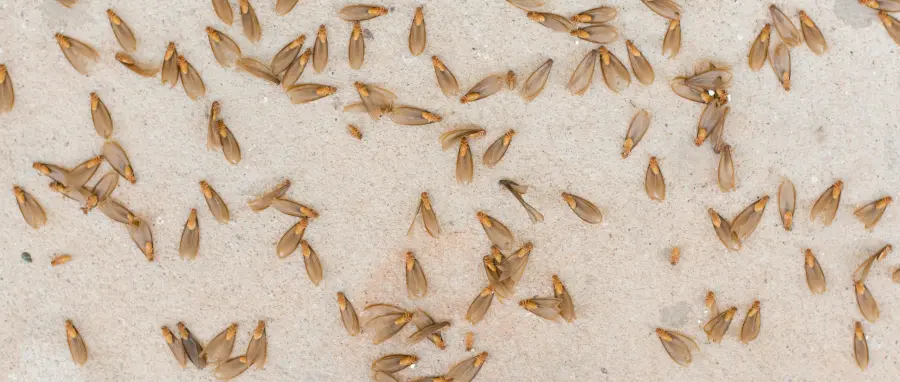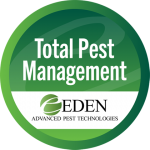When you picture a termite swarm, what comes to mind? Probably not the most comforting image. The idea of any swarm can be unsettling, but termite swarms are especially concerning. Why? Because they’re a sure sign of new termite colonies forming. The winged termites in the swarm, known as alates, are sent out to mate and establish new colonies. So, if you notice a termite swarm on your property, it’s likely that a new infestation has formed. They are your first indication that termites have been established, and inspection is needed ASAP to determine the severity.
Let’s talk about how to spot a termite swarm on your property, what it means, and what you should do about it.
What Do Termite Swarms Look Like?
Termite swarms are a group of winged termites flying together in large numbers, typically during warmer months when they are searching for a new location to settle. Here’s how you can identify a termite swarm:
- Large group of winged termites (alates): The swarm usually consists of dozens or even hundreds of termites together.
- Color: Alates are often dark brown or black, depending on the species.
- Size: Termite alates are around 1/4 to 1/2 inch long, including their wings.
- Wings: All the alates in a swarm have two pairs of wings that are almost equal in size. Their wings are translucent and often shed after they land.
- Timing of the swarm: Swarms typically occur after rainfall, in the spring or early summer when the air is warm and humid.
Different Types of Termite Swarms
While all termite swarms are concerning, it’s important to understand the difference between damwood termite swarms and subterranean termite swarms:
- Dampwood Termite Swarms: These swarm in late summer or early fall, thriving in moist and decaying wood without requiring contact with the soil. This leads them to establish colonies within damp wooden structures, including those found in homes. Dampwood termites are commonly encountered near sources of moisture, such as leaky pipes, in bathrooms, kitchens, and around windows and doorframes where wood is prone to water damage.
- Subterranean Termite Swarms: These termites usually swarm in the spring. They require contact with soil, meaning they build their colonies underground and often invade homes through foundational cracks or any wooden structures that touch the soil. Subterranean termites are more aggressive than dampwood termites and are capable of causing significant structural damage quickly.
What Are Termite Alates?
Termite alates are the winged reproductive members of a termite colony. Their sole purpose is to fly away from their original colony, mate, and form new colonies elsewhere. Once they’ve mated, the alates shed their wings and seek out a new location to start their colony, often in or near homes.
While alates themselves don’t cause structural damage, their presence is a major red flag for homeowners because it indicates that a mature termite colony is nearby.
How to Prevent Termite Swarms
The best way to avoid a termite infestation is to prevent a swarm from settling on your property in the first place. Here are some steps you can take to reduce your risk:
- Keep wood and debris away from your home’s foundation: Termites are attracted to wood, and having piles of firewood, mulch, or wood scraps near your home can invite them in.
- Ensure proper drainage around your property: Termites thrive in moist environments, so make sure water isn’t pooling around your foundation.
- Seal cracks and gaps: Check your foundation, windows, and doors for any cracks or gaps that termites could use to gain entry.
- Reduce wood-to-soil contact: Make sure wooden parts of your home, like decks and siding, don’t directly touch the soil.
- Schedule regular termite inspections: A professional inspection can catch early signs of termite activity before a full-blown infestation occurs.
What Should You Do If You See a Swarm of Termites?
If you spot a termite swarm on your property, it’s crucial to act quickly. Here’s what you should do:
- Stay calm: Termite swarms aren’t aggressive, so they’re not a direct threat to you. But they are a threat to your home.
- Close off the area: If the swarm is inside your home, close off the area where you see them to prevent them from spreading.
- Don’t disturb the swarm: Avoid using sprays or insecticides on the swarm as this could scatter the termites, making it harder to locate their origin.
- DIY control (with caution): While it’s tempting to handle the problem yourself, DIY termite control is often ineffective for swarms. However, if you want to try, proceed with caution and care.
- Call a professional: Contact us immediately to schedule a termite inspection. Our team can assess the situation and offer targeted termite control services to protect your home.
Dependable Termite Control in Spokane, WA and Coeur d'Alene, ID
Don’t let a termite swarm turn into a termite infestation. If you see swarms on your property, it’s time to act. Reach out to the expert termite control team at Eden Advanced Pest Technologies. We proudly serve the Spokane WA area and Northern Idaho. We’ll help you protect your home from these destructive pests.
Call us today for a free estimate.
Back to Termite Exterminators & Control

